seats MAZDA MODEL 3 HATCHBACK 2005 (in English) Owner's Guide
[x] Cancel search | Manufacturer: MAZDA, Model Year: 2005, Model line: MODEL 3 HATCHBACK, Model: MAZDA MODEL 3 HATCHBACK 2005Pages: 322, PDF Size: 4.7 MB
Page 53 of 322

Black plate (53,1)
WARNING
Hot Air Bag Inflators:
Hot air bag inflators are dangerous. Immediately after inflation, the inflators in the
steering wheel, dashboard, seatbacks, or the front and rear window pillars and along
the roof edge are very hot. You could get burned. Don't touch the internal components
of the air bag modules after the bags have inflated.
Installation of Front-End Equipment:
Installation of front-end equipment, such as frontal protection bar (kangaroo bar, bull
bar, push bar, etc.), snowplow, or winches, is dangerous. The air bag crash sensor
system could be affected. This could cause air bags to inflate unexpectedly, or it could
prevent the air bags from inflating during an accident. Front occupants could be
seriously injured. Never install any front-end equipment to your vehicle.
Suspension Adjustment:
Adjusting the vehicle suspension is dangerous. If the vehicle's height or the
suspension is changed, the vehicle will be unable to accurately detect a collision
resulting in incorrect or unexpected air bag deployment and the possibility of serious
injuries.
Modification of the Supplemental Restraint System:
Modifying the components or wiring of the supplemental restraint system is
dangerous. You could accidentally activate it or make it inoperable. Don't make any
modifications to the supplemental restraint system. This includes installing trim,
badges, or anything else over the air bag modules. It also includes installing extra
electrical equipment on or near system components or wiring. An Authorized Mazda
Dealer can provide the special care needed in the removal and installation of front
seats. It is important to protect the air bag wiring and connections to assure that the
bags do not accidentally deploy, the driver seat slide position sensor and front
passenger seat weight sensors are not damaged and that the seats retain an
undamaged air bag connection.
NOTE
lWhen an air bag deploys, a loud inflation noise can be heard and some smoke will be
released. Neither is likely to cause injury, however, the texture of the air bags may
cause light skin injuries on body parts not covered with clothing through friction.
lShould you sell your Mazda, we urge you to tell the new owner of its air bag systems
and that familiarization with all instructions about them, from the Owner's Manual, is
important.
Essential Safety Equipment
SRS Air Bags
2-39
Mazda3_8T97-EC-04J_Edition1 Page53
Saturday, September 25 2004 2:8 PM
Form No.8T97-EC-04J
Page 55 of 322

Black plate (55,1)
qFront Air Bag System Components
(4)
(8)
(7)
(5)
(8) (2)(9)(3) (1) (6)
(1) Front dual stage inflators and air bags
(2) Crash sensors and diagnostic module (SAS unit)
(3) Front air bag sensor
(4) Driver seat slide position sensor (page 2-43)
(5) Front passenger seat weight sensors (page 2-43)
(6) Front seats
(7) Driver and front passenger seat belt buckle switches (page 2-43)
(8) Front seat belt pretensioner and load limiting systems (page 2-14)
(9) Front passenger air bag deactivation indicator light (page 2-43)
Essential Safety Equipment
SRS Air Bags
2-41
Mazda3_8T97-EC-04J_Edition1 Page55
Saturday, September 25 2004 2:8 PM
Form No.8T97-EC-04J
Page 56 of 322
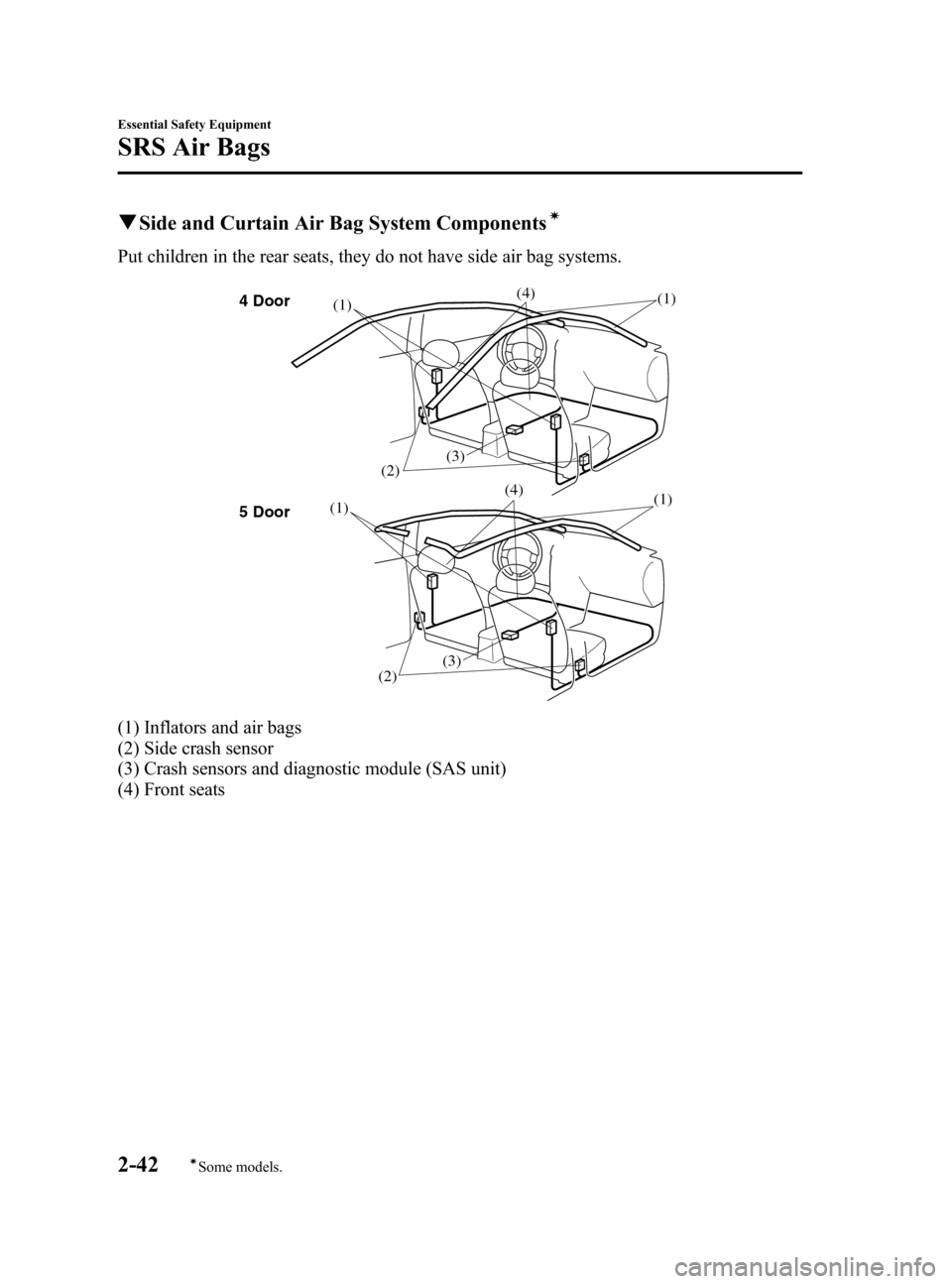
Black plate (56,1)
qSide and Curtain Air Bag System Componentsí
Put children in the rear seats, they do not have side air bag systems.
4 Door
5 Door(2) (1)(1)
(3)(4)
(3)
(2) (1)(1) (4)
(1) Inflators and air bags
(2) Side crash sensor
(3) Crash sensors and diagnostic module (SAS unit)
(4) Front seats
2-42
Essential Safety Equipment
íSome models.
SRS Air Bags
Mazda3_8T97-EC-04J_Edition1 Page56
Saturday, September 25 2004 2:8 PM
Form No.8T97-EC-04J
Page 60 of 322
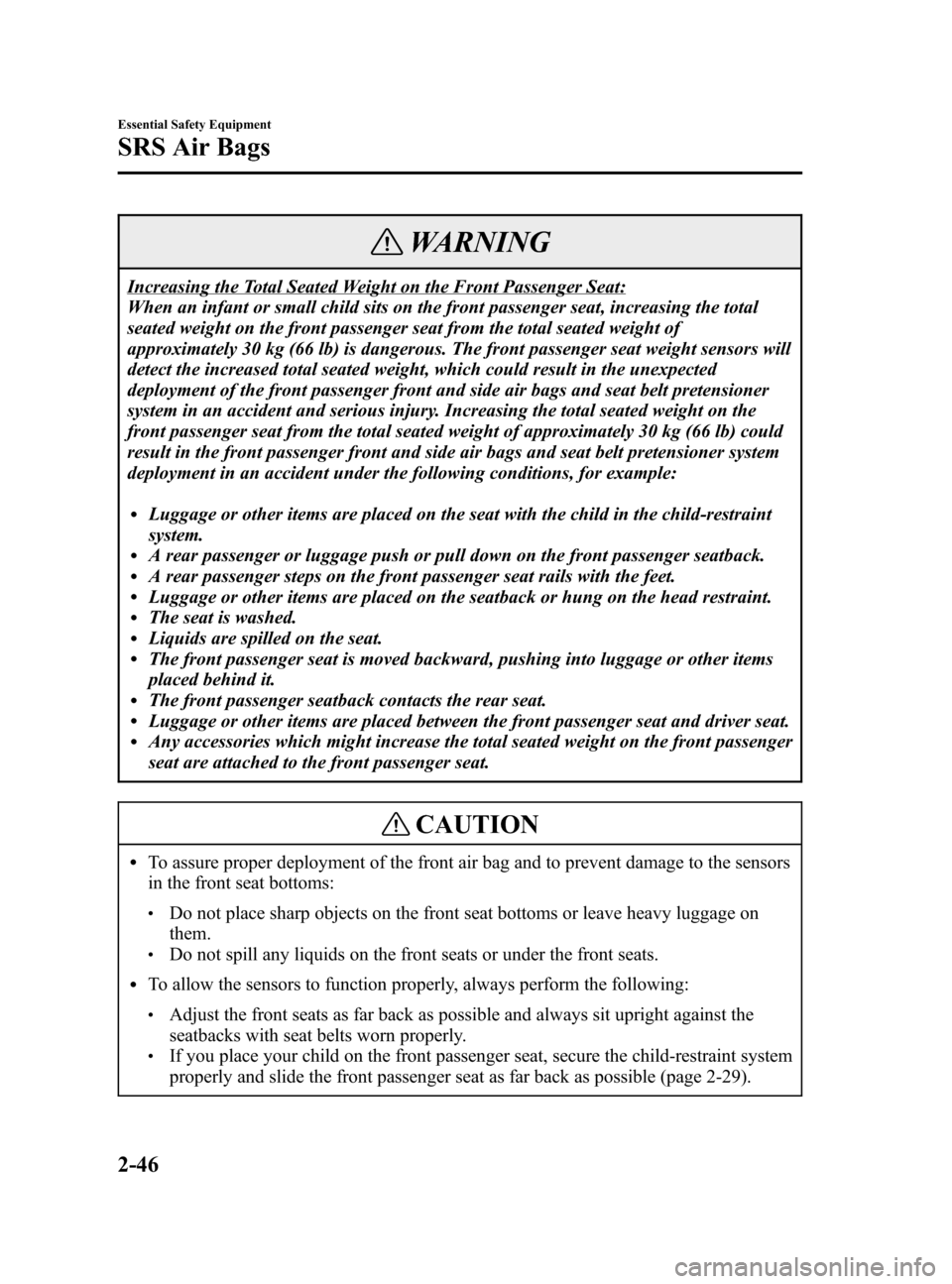
Black plate (60,1)
WARNING
Increasing the Total Seated Weight on the Front Passenger Seat:
When an infant or small child sits on the front passenger seat, increasing the total
seated weight on the front passenger seat from the total seated weight of
approximately 30 kg (66 lb) is dangerous. The front passenger seat weight sensors will
detect the increased total seated weight, which could result in the unexpected
deployment of the front passenger front and side air bags and seat belt pretensioner
system in an accident and serious injury. Increasing the total seated weight on the
front passenger seat from the total seated weight of approximately 30 kg (66 lb) could
result in the front passenger front and side air bags and seat belt pretensioner system
deployment in an accident under the following conditions, for example:
lLuggage or other items are placed on the seat with the child in the child-restraint
system.
lA rear passenger or luggage push or pull down on the front passenger seatback.lA rear passenger steps on the front passenger seat rails with the feet.lLuggage or other items are placed on the seatback or hung on the head restraint.lThe seat is washed.lLiquids are spilled on the seat.lThe front passenger seat is moved backward, pushing into luggage or other items
placed behind it.
lThe front passenger seatback contacts the rear seat.lLuggage or other items are placed between the front passenger seat and driver seat.lAny accessories which might increase the total seated weight on the front passenger
seat are attached to the front passenger seat.
CAUTION
lTo assure proper deployment of the front air bag and to prevent damage to the sensors
in the front seat bottoms:
lDo not place sharp objects on the front seat bottoms or leave heavy luggage on
them.
lDo not spill any liquids on the front seats or under the front seats.
lTo allow the sensors to function properly, always perform the following:
lAdjust the front seats as far back as possible and always sit upright against the
seatbacks with seat belts worn properly.
lIf you place your child on the front passenger seat, secure the child-restraint system
properly and slide the front passenger seat as far back as possible (page 2-29).
2-46
Essential Safety Equipment
SRS Air Bags
Mazda3_8T97-EC-04J_Edition1 Page60
Saturday, September 25 2004 2:8 PM
Form No.8T97-EC-04J
Page 61 of 322
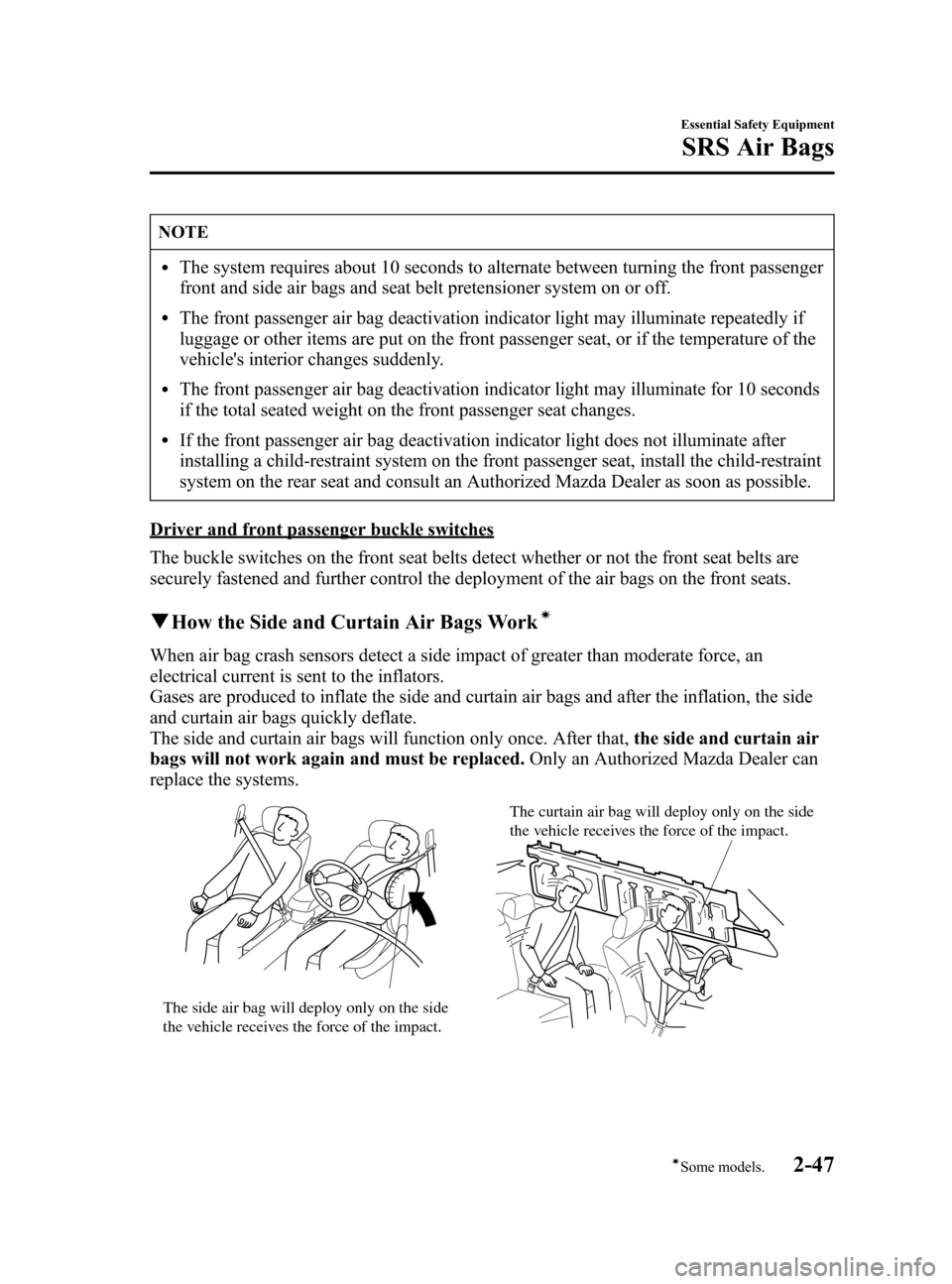
Black plate (61,1)
NOTE
lThe system requires about 10 seconds to alternate between turning the front passenger
front and side air bags and seat belt pretensioner system on or off.
lThe front passenger air bag deactivation indicator light may illuminate repeatedly if
luggage or other items are put on the front passenger seat, or if the temperature of the
vehicle's interior changes suddenly.
lThe front passenger air bag deactivation indicator light may illuminate for 10 seconds
if the total seated weight on the front passenger seat changes.
lIf the front passenger air bag deactivation indicator light does not illuminate after
installing a child-restraint system on the front passenger seat, install the child-restraint
system on the rear seat and consult an Authorized Mazda Dealer as soon as possible.
Driver and front passenger buckle switches
The buckle switches on the front seat belts detect whether or not the front seat belts are
securely fastened and further control the deployment of the air bags on the front seats.
qHow the Side and Curtain Air Bags Workí
When air bag crash sensors detect a side impact of greater than moderate force, an
electrical current is sent to the inflators.
Gases are produced to inflate the side and curtain air bags and after the inflation, the side
and curtain air bags quickly deflate.
The side and curtain air bags will function only once. After that,the side and curtain air
bags will not work again and must be replaced.Only an Authorized Mazda Dealer can
replace the systems.
The side air bag will deploy only on the side
the vehicle receives the force of the impact.The curtain air bag will deploy only on the side
the vehicle receives the force of the impact.
Essential Safety Equipment
SRS Air Bags
2-47íSome models. Mazda3_8T97-EC-04J_Edition1 Page61
Saturday, September 25 2004 2:8 PM
Form No.8T97-EC-04J
Page 62 of 322
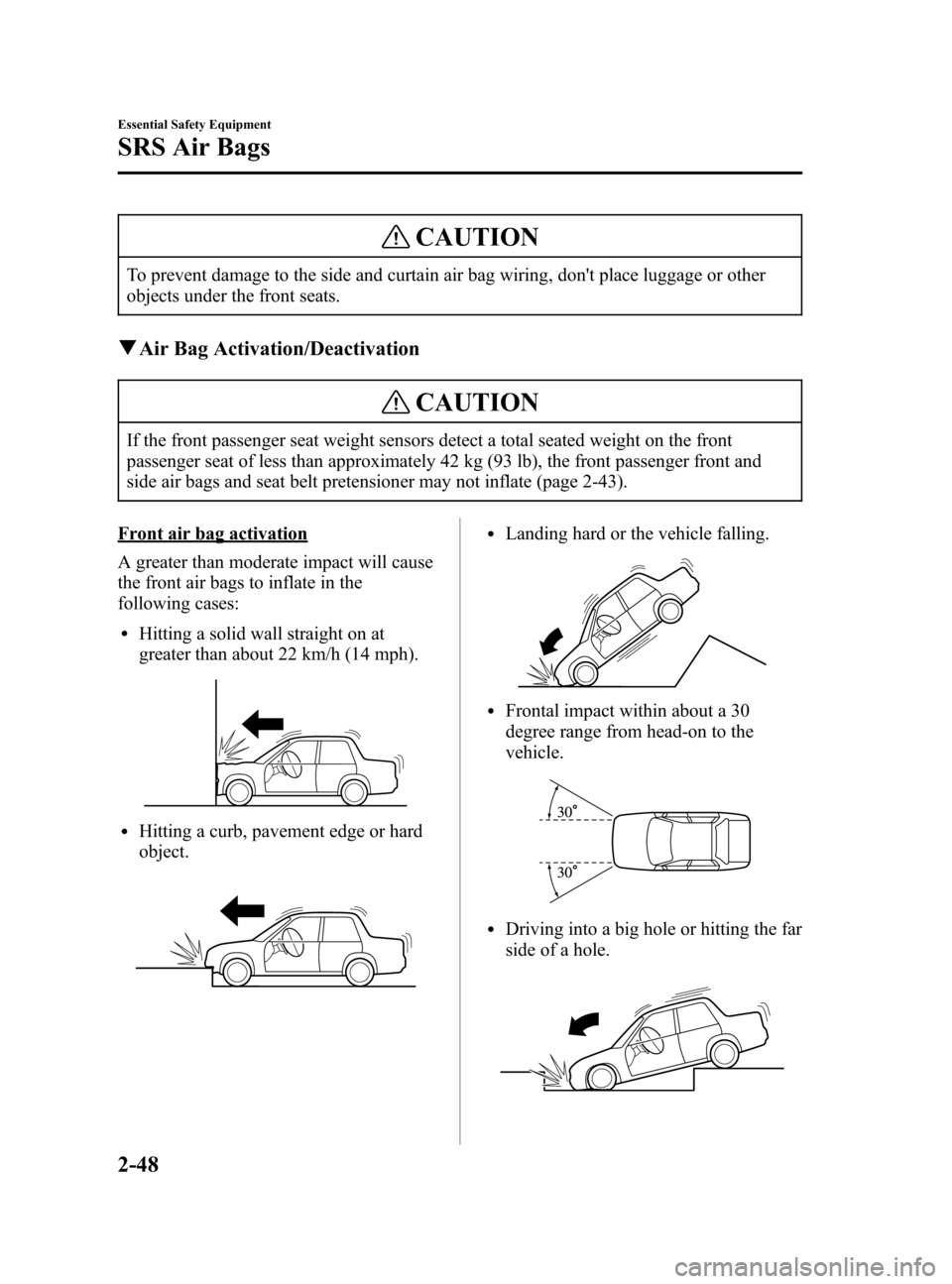
Black plate (62,1)
CAUTION
To prevent damage to the side and curtain air bag wiring, don't place luggage or other
objects under the front seats.
qAir Bag Activation/Deactivation
CAUTION
If the front passenger seat weight sensors detect a total seated weight on the front
passenger seat of less than approximately 42 kg (93 lb), the front passenger front and
side air bags and seat belt pretensioner may not inflate (page 2-43).
Front air bag activation
A greater than moderate impact will cause
the front air bags to inflate in the
following cases:
lHitting a solid wall straight on at
greater than about 22 km/h (14 mph).
lHitting a curb, pavement edge or hard
object.
lLanding hard or the vehicle falling.
lFrontal impact within about a 30
degree range from head-on to the
vehicle.
lDriving into a big hole or hitting the far
side of a hole.
2-48
Essential Safety Equipment
SRS Air Bags
Mazda3_8T97-EC-04J_Edition1 Page62
Saturday, September 25 2004 2:8 PM
Form No.8T97-EC-04J
Page 66 of 322
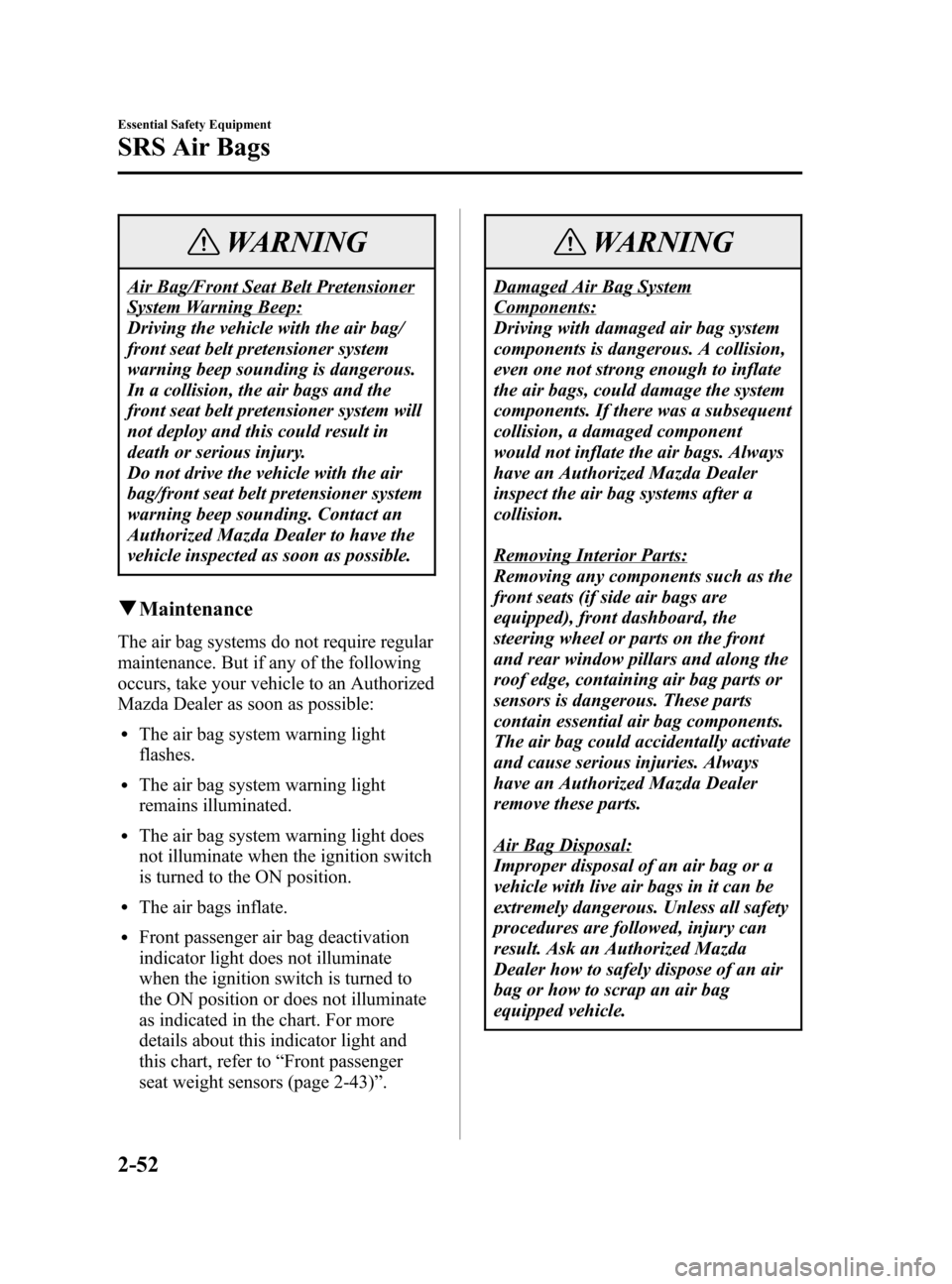
Black plate (66,1)
WARNING
Air Bag/Front Seat Belt Pretensioner
System Warning Beep:
Driving the vehicle with the air bag/
front seat belt pretensioner system
warning beep sounding is dangerous.
In a collision, the air bags and the
front seat belt pretensioner system will
not deploy and this could result in
death or serious injury.
Do not drive the vehicle with the air
bag/front seat belt pretensioner system
warning beep sounding. Contact an
Authorized Mazda Dealer to have the
vehicle inspected as soon as possible.
qMaintenance
The air bag systems do not require regular
maintenance. But if any of the following
occurs, take your vehicle to an Authorized
Mazda Dealer as soon as possible:
lThe air bag system warning light
flashes.
lThe air bag system warning light
remains illuminated.
lThe air bag system warning light does
not illuminate when the ignition switch
is turned to the ON position.
lThe air bags inflate.
lFront passenger air bag deactivation
indicator light does not illuminate
when the ignition switch is turned to
the ON position or does not illuminate
as indicated in the chart. For more
details about this indicator light and
this chart, refer to“Front passenger
seat weight sensors (page 2-43)”.
WARNING
Damaged Air Bag System
Components:
Driving with damaged air bag system
components is dangerous. A collision,
even one not strong enough to inflate
the air bags, could damage the system
components. If there was a subsequent
collision, a damaged component
would not inflate the air bags. Always
have an Authorized Mazda Dealer
inspect the air bag systems after a
collision.
Removing Interior Parts:
Removing any components such as the
front seats (if side air bags are
equipped), front dashboard, the
steering wheel or parts on the front
and rear window pillars and along the
roof edge, containing air bag parts or
sensors is dangerous. These parts
contain essential air bag components.
The air bag could accidentally activate
and cause serious injuries. Always
have an Authorized Mazda Dealer
remove these parts.
Air Bag Disposal:
Improper disposal of an air bag or a
vehicle with live air bags in it can be
extremely dangerous. Unless all safety
procedures are followed, injury can
result. Ask an Authorized Mazda
Dealer how to safely dispose of an air
bag or how to scrap an air bag
equipped vehicle.
2-52
Essential Safety Equipment
SRS Air Bags
Mazda3_8T97-EC-04J_Edition1 Page66
Saturday, September 25 2004 2:8 PM
Form No.8T97-EC-04J
Page 81 of 322
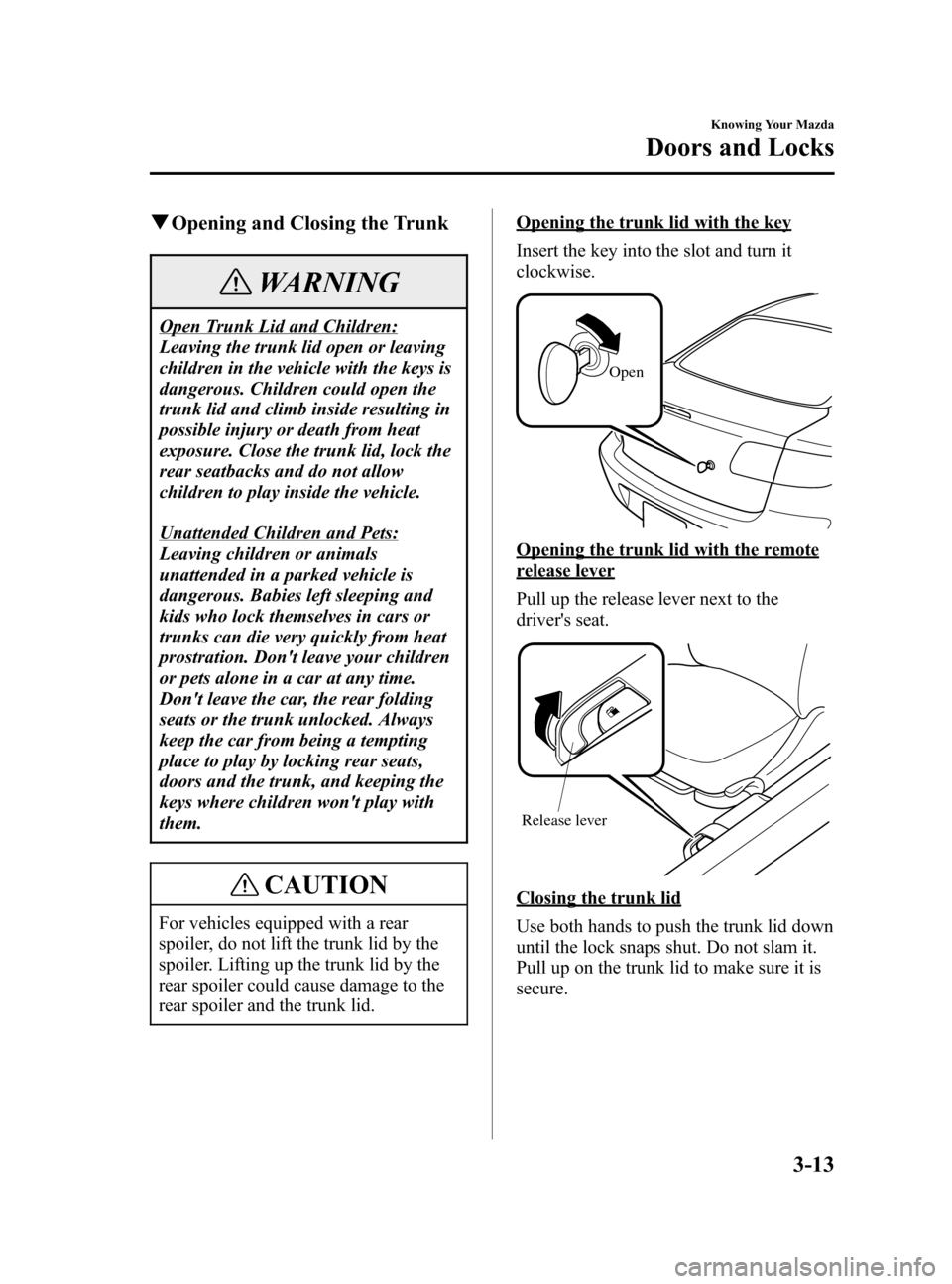
Black plate (81,1)
qOpening and Closing the Trunk
WARNING
Open Trunk Lid and Children:
Leaving the trunk lid open or leaving
children in the vehicle with the keys is
dangerous. Children could open the
trunk lid and climb inside resulting in
possible injury or death from heat
exposure. Close the trunk lid, lock the
rear seatbacks and do not allow
children to play inside the vehicle.
Unattended Children and Pets:
Leaving children or animals
unattended in a parked vehicle is
dangerous. Babies left sleeping and
kids who lock themselves in cars or
trunks can die very quickly from heat
prostration. Don't leave your children
or pets alone in a car at any time.
Don't leave the car, the rear folding
seats or the trunk unlocked. Always
keep the car from being a tempting
place to play by locking rear seats,
doors and the trunk, and keeping the
keys where children won't play with
them.
CAUTION
For vehicles equipped with a rear
spoiler, do not lift the trunk lid by the
spoiler. Lifting up the trunk lid by the
rear spoiler could cause damage to the
rear spoiler and the trunk lid.
Opening the trunk lid with the key
Insert the key into the slot and turn it
clockwise.
Open
Opening the trunk lid with the remote
release lever
Pull up the release lever next to the
driver's seat.
Release lever
Closing the trunk lid
Use both hands to push the trunk lid down
until the lock snaps shut. Do not slam it.
Pull up on the trunk lid to make sure it is
secure.
Knowing Your Mazda
Doors and Locks
3-13
Mazda3_8T97-EC-04J_Edition1 Page81
Saturday, September 25 2004 2:8 PM
Form No.8T97-EC-04J
Page 83 of 322
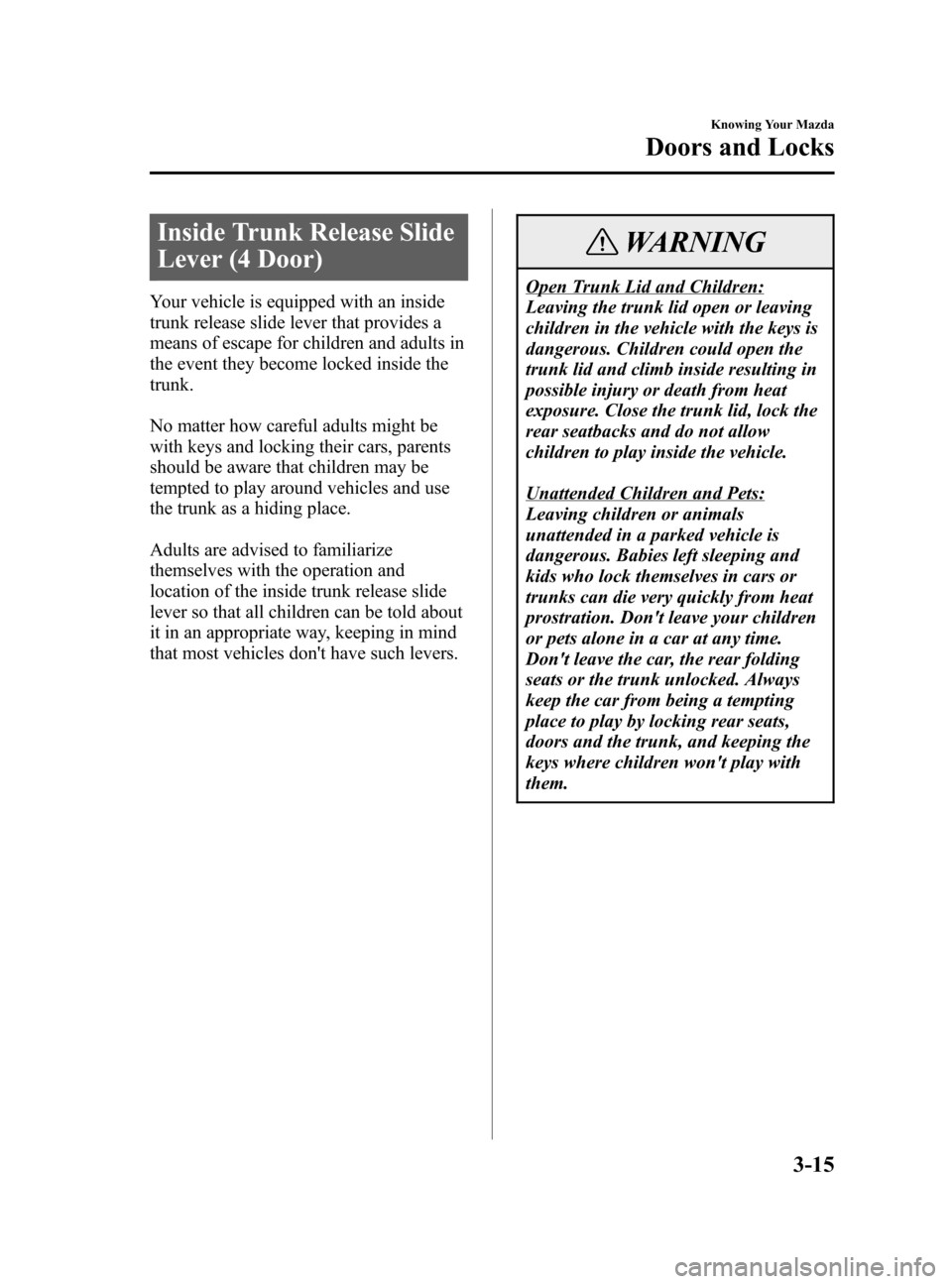
Black plate (83,1)
Inside Trunk Release Slide
Lever (4 Door)
Your vehicle is equipped with an inside
trunk release slide lever that provides a
means of escape for children and adults in
the event they become locked inside the
trunk.
No matter how careful adults might be
with keys and locking their cars, parents
should be aware that children may be
tempted to play around vehicles and use
the trunk as a hiding place.
Adults are advised to familiarize
themselves with the operation and
location of the inside trunk release slide
lever so that all children can be told about
it in an appropriate way, keeping in mind
that most vehicles don't have such levers.
WARNING
Open Trunk Lid and Children:
Leaving the trunk lid open or leaving
children in the vehicle with the keys is
dangerous. Children could open the
trunk lid and climb inside resulting in
possible injury or death from heat
exposure. Close the trunk lid, lock the
rear seatbacks and do not allow
children to play inside the vehicle.
Unattended Children and Pets:
Leaving children or animals
unattended in a parked vehicle is
dangerous. Babies left sleeping and
kids who lock themselves in cars or
trunks can die very quickly from heat
prostration. Don't leave your children
or pets alone in a car at any time.
Don't leave the car, the rear folding
seats or the trunk unlocked. Always
keep the car from being a tempting
place to play by locking rear seats,
doors and the trunk, and keeping the
keys where children won't play with
them.
Knowing Your Mazda
Doors and Locks
3-15
Mazda3_8T97-EC-04J_Edition1 Page83
Saturday, September 25 2004 2:8 PM
Form No.8T97-EC-04J
Page 319 of 322
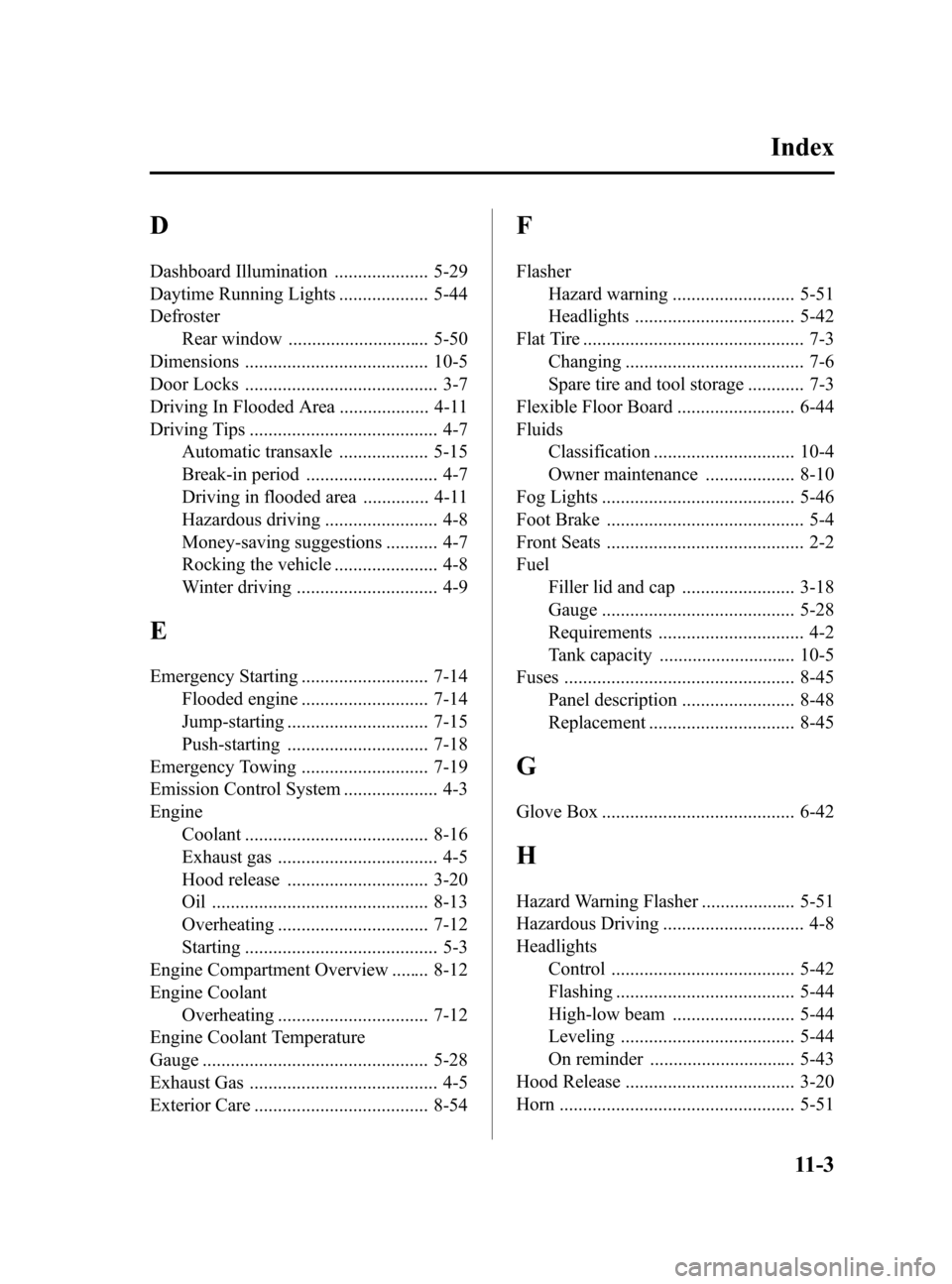
Black plate (319,1)
D
Dashboard Illumination .................... 5-29
Daytime Running Lights ................... 5-44
Defroster
Rear window .............................. 5-50
Dimensions ....................................... 10-5
Door Locks ......................................... 3-7
Driving In Flooded Area ................... 4-11
Driving Tips ........................................ 4-7
Automatic transaxle ................... 5-15
Break-in period ............................ 4-7
Driving in flooded area .............. 4-11
Hazardous driving ........................ 4-8
Money-saving suggestions ........... 4-7
Rocking the vehicle ...................... 4-8
Winter driving .............................. 4-9
E
Emergency Starting ........................... 7-14
Flooded engine ........................... 7-14
Jump-starting .............................. 7-15
Push-starting .............................. 7-18
Emergency Towing ........................... 7-19
Emission Control System .................... 4-3
Engine
Coolant ....................................... 8-16
Exhaust gas .................................. 4-5
Hood release .............................. 3-20
Oil .............................................. 8-13
Overheating ................................ 7-12
Starting ......................................... 5-3
Engine Compartment Overview ........ 8-12
Engine Coolant
Overheating ................................ 7-12
Engine Coolant Temperature
Gauge ................................................ 5-28
Exhaust Gas ........................................ 4-5
Exterior Care ..................................... 8-54
F
Flasher
Hazard warning .......................... 5-51
Headlights .................................. 5-42
Flat Tire ............................................... 7-3
Changing ...................................... 7-6
Spare tire and tool storage ............ 7-3
Flexible Floor Board ......................... 6-44
Fluids
Classification .............................. 10-4
Owner maintenance ................... 8-10
Fog Lights ......................................... 5-46
Foot Brake .......................................... 5-4
Front Seats .......................................... 2-2
Fuel
Filler lid and cap ........................ 3-18
Gauge ......................................... 5-28
Requirements ............................... 4-2
Tank capacity ............................. 10-5
Fuses ................................................. 8-45
Panel description ........................ 8-48
Replacement ............................... 8-45
G
Glove Box ......................................... 6-42
H
Hazard Warning Flasher .................... 5-51
Hazardous Driving .............................. 4-8
Headlights
Control ....................................... 5-42
Flashing ...................................... 5-44
High-low beam .......................... 5-44
Leveling ..................................... 5-44
On reminder ............................... 5-43
Hood Release .................................... 3-20
Horn .................................................. 5-51
Index
11-3
Mazda3_8T97-EC-04J_Edition1 Page319
Saturday, September 25 2004 2:17 PM
Form No.8T97-EC-04J